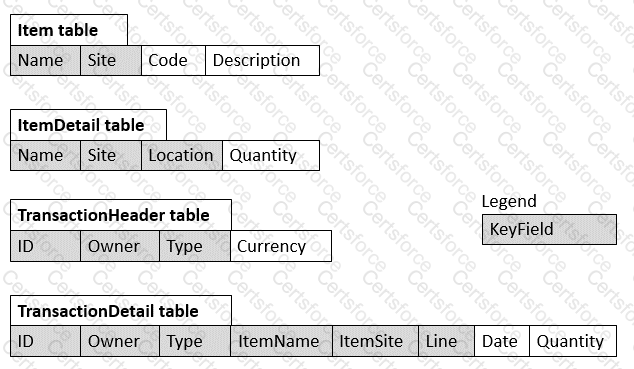You have defined a new namespace, TRM. You now want to define a new table that has a key reference field to the Mfg::ABCCode table. However, in the Add Input Field dialog,ABCCode does not appear.
What should you do to create the ABCCode key reference?
You are asked to transform PlannedOrder data into new ScheduledReceipt records, assuming just one PartSource per part and no maximum quantity. You need to filter the PlannedOrder records to ensure you do not try to create any ScheduledReceipt records which already exist. The workbook includes a worksheet, LKPScheduledReceipt, on existing converted ScheduledReceipts and follows Kinaxis best practices.
In this situation, which filter expression will follow KInaixs best practices and provide the best performance to include PlannedOrder records that do not match existing ScheduledReceipt records?
You have a worksheet based on the IndependentDemand table that includes columns for key fields plus multi-scenario columns for Quantity and EffectiveDemand. You want to highlight the Quantity fields where the value in the comparison scenario is different from the corresponding value in the workbook's baseline scenario. You want your worksheet to be able to highlight differences in several scenarios.
How would you achieve this highlighting?
You are creating a resource that is designed to evaluate the impact of converting planned orders to scheduled receipts. After the evaluation is complete, you want to provide users the opportunity to push their changes to the parent scenario. Users will be using their scenarios to consider changes to lead time, constraint available, and other planning parameters. The company policy stipulates that lead times cannot be adjusted in any shared scenarios.
What should you do to accomplish this task?
You have a worksheet based on the Part table. You want to know the total number of unique customers that have orders for each part.
Which expression accomplishes this task?
Your suppliers need to receive a report listing their outstanding purchase orders. Each supplier should receive the report in the same format but it should only display the purchase orders associated with their supplier ID.
Based on this situation, which two actions will be required to support this requirement? (Choose two.)
Choose 2 answers
You are developing a worksheet that will be used to run a script through a form. For the script to work properly, you will need to pass information from two columns as script arguments.
Which two actions will accomplish this task? (Choose two.)
Choose 2 answers

The tables shown in the graphic are from an SQL database. Shaded fields indicate key fields in SQL.
Which three actions should you take to design this data model in RapidResponse? (Choose three.)
Choose 3 answers